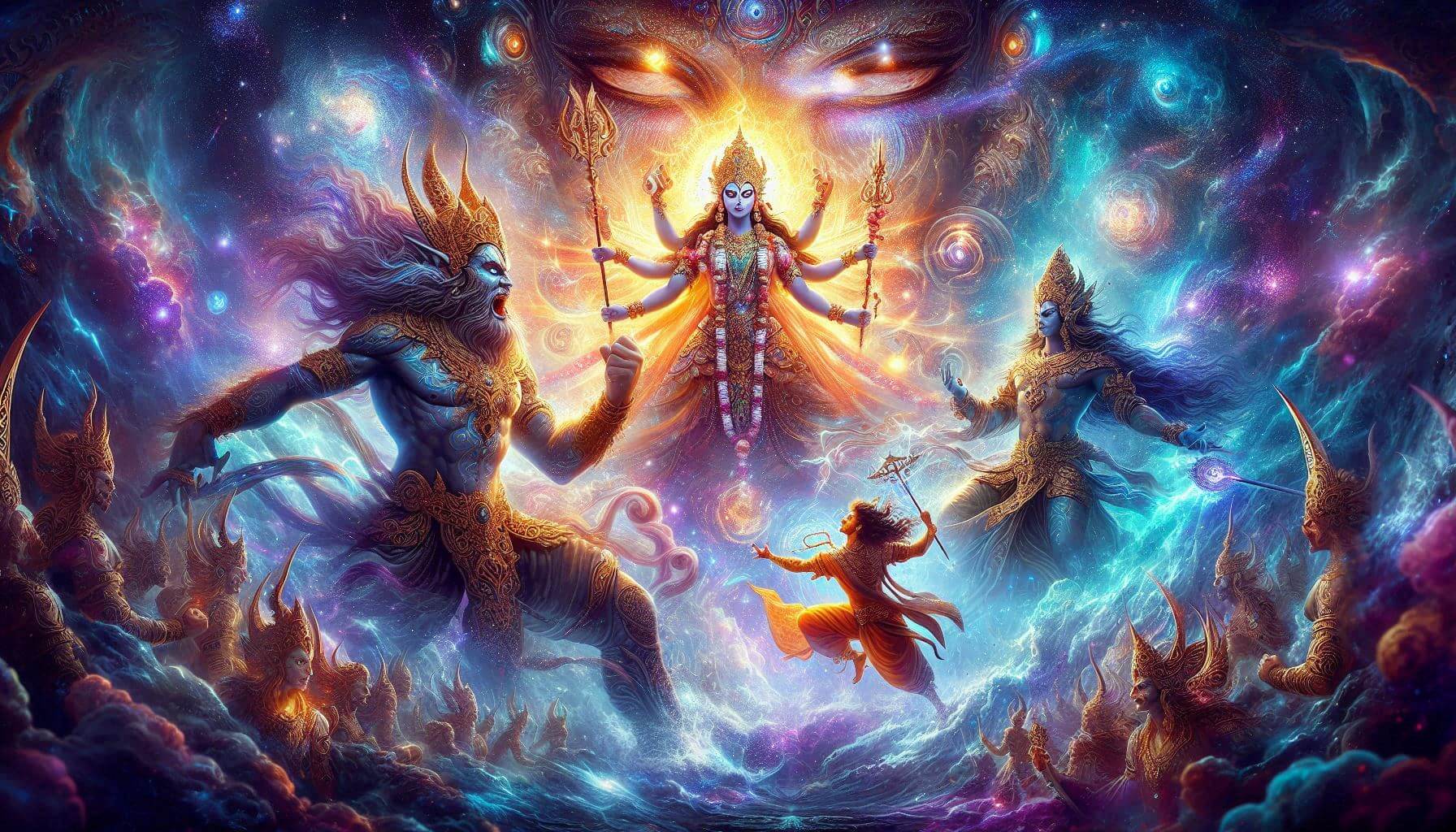The Cosmic Battle of Madhu and Kaitabha
Devi Bhagavata Purana / The Cosmic Battle of Madhu and Kaitabha
The Cosmic Battle of Madhu and Kaitabha
The Battle with Madhu and Kaitabha: When the Goddess Awakened Creation

Source: Devi Bhagavata Purana, also called Devi Purana or Durga Purana
In the beginning, when the universe was submerged in endless waters and silence prevailed everywhere, Lord Brahma appeared upon a lotus flower that sprouted from the navel of the cosmic being, Lord Vishnu. Yet Brahma, the creator, was filled with confusion. Seated upon the vast lotus, surrounded by nothing but the infinite ocean, he wondered:
“How have I come into being? Who is my creator? Upon what does this water rest, and who sustains it all? From where has this lotus emerged?”
Determined to find the answers, Brahma descended down the lotus stalk into the cosmic waters. For a thousand years he journeyed downward, seeking the end of the lotus stem and the truth of his origin. But the waters stretched endlessly, with no foundation or limit in sight.
Then, from the vast ether, a divine voice echoed:
“Tap karo, tap karo.” (Perform penance. Meditate.)
Obeying the celestial command, Brahma sat in meditation for five thousand years, performing intense penance. At the end of his tapasya, the same divine voice again resounded through the void:
“Create! Begin the act of creation.”
Perplexed, Brahma wondered what he was to create and how. Before he could act, two ferocious demons—Madhu and Kaitabha—rose from the cosmic waters. Born from the earwax of Vishnu during His slumber, these asuras were embodiments of arrogance and ignorance. Filled with pride, they challenged Brahma to battle.
Frightened and helpless, Brahma clung to the lotus stalk and descended once more into the waters. There, amidst the serpent waves, he beheld a magnificent divine figure—Lord Vishnu, dark as monsoon clouds, clad in yellow silk, and resting upon the thousand-hooded Shesh Nag. But Vishnu was fast asleep, unmoved by the turmoil around Him.
Seeing the protector of the universe in deep slumber, Brahma grew anxious. It was then that he remembered Goddess Durga, the eternal Divine Energy, the Shakti who empowers all beings. Calling upon Her with deep devotion, Brahma prayed for Her help.
Instantly, Goddess Durga appeared, radiating brilliant light, adorned with celestial ornaments, riding high in the heavens. She emerged from Vishnu’s body, for it was She—the primordial power—who had veiled Him in sleep. As She departed from His being, Vishnu immediately awoke, His awareness restored by Her divine presence.
Now awakened and empowered by the Goddess, Vishnu engaged in battle with the two asuras, Madhu and Kaitabha. The fight raged for five thousand years, the waters of the cosmic ocean trembling under their might. Yet the demons, proud of their strength, could not be subdued. It was only when Goddess Durga manifested again before them—radiant and enchanting—that their minds were ensnared by Her beauty. In their distraction and arrogance, they lost focus and fell into illusion. In that moment, Vishnu struck them down, ending their reign of chaos.
With the slaying of Madhu and Kaitabha, cosmic order was restored. At that divine moment, Lord Shiva too appeared, and together Brahma, Vishnu, and Rudra praised the Supreme Goddess who had rescued them all.
Then the Divine Mother spoke:
“O Brahma! O Vishnu! O Rudra! The two great demons are slain. Now, abandon your inertia and fulfill your divine duties— Create, preserve, and destroy the Universe as ordained.”
With Her command, the three deities assumed their cosmic roles—Brahma to create, Vishnu to preserve, and Shiva to dissolve—each empowered by the energy of Adi Shakti, the eternal source of all power and consciousness.
Conclusion
The account of Madhu and Kaitabha in the Devi Bhagavad Purana unveils a deep spiritual truth: even the greatest gods—Brahma, Vishnu, and Shiva—are dependent upon the power of Adi Shakti, the Supreme Goddess. Vishnu, the preserver of the universe, lay in a state of complete dormancy until the Goddess manifested. Brahma, newly awakened on the lotus, was engulfed in confusion and unable to comprehend his own origin. Only with the appearance of the Devi did creation resume, order return, and divine purpose reawaken.
A striking revelation in this narrative is that Brahma has no knowledge of how he came into existence. The moment he gained consciousness, he found himself seated upon the lotus but remained clueless about its source. Even after descending along the lotus stalk and performing prolonged penance, he could not uncover his origin—demonstrating that he is not all-knowing and, therefore, not supreme.
This episode also highlights that Goddess Durga was residing within Vishnu, keeping him subdued. Only when She emerged from his body did Vishnu regain awareness and rise to confront Madhu and Kaitabha. Yet even then, despite being the proclaimed Lord of the three worlds, Vishnu was unable to defeat the demons through his own strength. They were slain only after being distracted by the captivating presence of the Goddess—clearly affirming that Vishnu is not independent or supreme.
Finally, the text states that Rudra (Shiva) also appeared at the scene, and all three—Brahma, Vishnu, and Shiva—offered praises to Goddess Durga. This collective act of worship underscores a crucial truth: the Trimurti themselves acknowledge the superiority and authority of their Mother. Their submission reaffirms that Goddess Durga is far more powerful than the three deities and is the force behind their abilities.